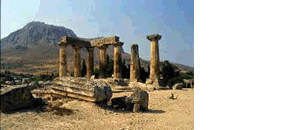 |
|
|
|
|
Class
Prep
|
|
|
|
- Greece:
Aeschylus' Oresteia, "Agamemnon"
-

- In today's conclusion of Aeschylus' Agamemnon,
the cycle of bloodshed continues and becomes more complicated.
-
- As you read the conclusion of the play, Agamemnon, look
for further examples of dramatic irony in Clytemnestra's
speeches. An online exercise
is available to help you refine your skills.
-
- Consider the following issues and questions:
-
-
- In what ways is Clytemnestra portrayed as a "man"?
Make a list of specific words and phrases and their
line references, and be prepared to discuss the implications
of the gendering of violence.
- Be able to identify the background and plot function of Cassandra.
- How does this play resolve, and what is the gods' role in both the dilemma and this resolution?
-
-
- Assigned Readings
- Primary: "Agamemnon" (pp. 71 [line 782]
-117 of the Oresteia book
- Secondary: Review Lloyd-Jones' "Introduction"
to the Oresteia on pp.3-23 of the Oresteia
book; online class prep
-
-
- Further Reading
 Burkert, Walter. Greek Religion, trans. John
Raffan. Cambridge, Massachusetts: Harvard University
Press, 1985.
Burkert, Walter. Greek Religion, trans. John
Raffan. Cambridge, Massachusetts: Harvard University
Press, 1985.
-
 --------. Homo Necans: The Anthropology of Ancient
Greek Sacrificial Ritual and Myth, trans. Peter Bing. Berkeley:
University of California Press, 1983.
--------. Homo Necans: The Anthropology of Ancient
Greek Sacrificial Ritual and Myth, trans. Peter Bing. Berkeley:
University of California Press, 1983.
-
 --------. Structure and History in Greek Mythology
and Ritual. Berkeley: University of California
Press, 1979.
--------. Structure and History in Greek Mythology
and Ritual. Berkeley: University of California
Press, 1979.
-
 Detienne, Marcel. The Creation of Mythology, trans. Margaret Cook. Chicago: University of Chicago, 1986.
Detienne, Marcel. The Creation of Mythology, trans. Margaret Cook. Chicago: University of Chicago, 1986.
-
 Detienne, Marcel and Jean-Pierre Vernant, ed. The
Cuisine of Sacrifice among the Greeks, trans. Paula Wissing. Chicago:
University of Chicago, 1989.
Detienne, Marcel and Jean-Pierre Vernant, ed. The
Cuisine of Sacrifice among the Greeks, trans. Paula Wissing. Chicago:
University of Chicago, 1989.
-
 Dodds, E. R. The Greeks and the Irrational. Berkeley:
University of California Press, 1951.
Dodds, E. R. The Greeks and the Irrational. Berkeley:
University of California Press, 1951.
-
 Easterling, P. E. and J. V. Muir, eds. Greek Religion
and Society. New York: Cambridge University Press,
1985.
Easterling, P. E. and J. V. Muir, eds. Greek Religion
and Society. New York: Cambridge University Press,
1985.
-
 Nilsson, Martin P. A History of Greek Religion,
2d ed. New York: Norton, 1964.
Nilsson, Martin P. A History of Greek Religion,
2d ed. New York: Norton, 1964.
-
 --------. The Minoan-Mycenaean Religion and Its
Survival in Greek Religion, 2d rev. ed. New York:
Biblo and Tannen, 1971.
--------. The Minoan-Mycenaean Religion and Its
Survival in Greek Religion, 2d rev. ed. New York:
Biblo and Tannen, 1971.
-
 --------. Greek Piety, trans. Herbert Jennings
Rose. Oxford: Claredon, 1948.
--------. Greek Piety, trans. Herbert Jennings
Rose. Oxford: Claredon, 1948.
-
 --------. Greek Popular Religion. Philadelphia:
University of Pennsylvania, 1998; original, New York: Columbia
University Press, 1940.
--------. Greek Popular Religion. Philadelphia:
University of Pennsylvania, 1998; original, New York: Columbia
University Press, 1940.
-
 Rice, David G. and John E. Stambaugh. Sources for the Study of Greek Religion. Missoula, Montana: Scholars Press, 1979.
Rice, David G. and John E. Stambaugh. Sources for the Study of Greek Religion. Missoula, Montana: Scholars Press, 1979.
-
 Vernant, Jean-Pierre. Myth and Society in Ancient
Greece, trans. Janet Lloyd. New York: Zone, 1988.
Vernant, Jean-Pierre. Myth and Society in Ancient
Greece, trans. Janet Lloyd. New York: Zone, 1988.
-
 --------. Myth and Thought among the Greeks. Boston: Routledge and Kegan Paul, 1983.
--------. Myth and Thought among the Greeks. Boston: Routledge and Kegan Paul, 1983.
-
 Vernant, Jean-Pierre and P. Vidal-Naquet. Myth and Tragedy in Ancient Greece, trans. Janet Lloyd. New York: Zone, 1988.
Vernant, Jean-Pierre and P. Vidal-Naquet. Myth and Tragedy in Ancient Greece, trans. Janet Lloyd. New York: Zone, 1988.
-
 Zaidman, Louise Bruit and Pauline Schmitt Pantel. Religion
in the Ancient Greek City, trans. Paul Cartledge. New
York: Cambridge University Press, 1992; original, Paris:
Armand Colin, 1989.
Zaidman, Louise Bruit and Pauline Schmitt Pantel. Religion
in the Ancient Greek City, trans. Paul Cartledge. New
York: Cambridge University Press, 1992; original, Paris:
Armand Colin, 1989.
-
-
- Links
-
-
-
- Sources
- Photograph: "Gold Mask from the Acropolis of Mycenae, mid
16th century BCE," Hannibal Slides Set No. 10 (Athens National
Museum), National Archaeological Museum, Athens.
|
|
|
|
|
